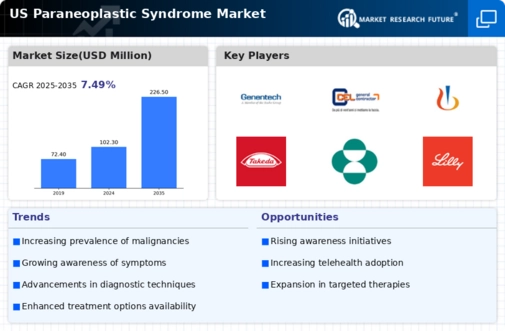The competitive landscape of the US Paraneoplastic Syndrome Market is characterized by a range of companies engaged in the development and provision of therapeutic solutions targeted at the unique challenges posed by this cancer-associated disorder. Paraneoplastic syndromes encompass a broad spectrum of symptoms that can occur in patients with malignancies, leading to a heightened demand for specialized treatments within the healthcare sector. This market segment features key players focusing on innovative drug development, enhancing patient care, and improving diagnostic methods to better identify and manage paraneoplastic conditions.
As awareness of these syndromes increases, companies are investing in research and development initiatives, collaborating with healthcare professionals, and pursuing strategic partnerships to strengthen their market position and influence.
Genentech has established a significant presence in the US Paraneoplastic Syndrome Market, driven by its research-oriented approach and comprehensive portfolio of biologic therapies. The company is well-regarded for its longstanding commitment to addressing serious health conditions, which includes targeted therapies that can alleviate symptoms associated with paraneoplastic syndromes. Genentech's strengths lie in its scientific expertise, strong brand recognition, and a collaborative approach with healthcare providers, which enhances its ability to bring innovative solutions to market. Additionally, the company invests heavily in clinical research, thus enabling it to stay at the forefront of advancements in the treatment landscape.
By leveraging its knowledge base and patient-centric focus, Genentech continues to play a pivotal role within this specialized therapeutic segment.
Celgene, a prominent player in the US Paraneoplastic Syndrome Market, is recognized for its robust portfolio of therapies that include both targeted and immunotherapies designed to address the complex interplay between cancer and related syndromes. The company has made significant strides in enhancing its market presence through strategic mergers and acquisitions that bolster its capabilities in drug development and commercialization. Celgene's strengths are rooted in its innovation-driven culture and its commitment to improving the lives of patients affected by serious illnesses.
Key products and services from Celgene target various aspects of paraneoplastic syndrome management, enabling healthcare providers to offer comprehensive treatment options. Furthermore, the company's proactive approach in engaging with the medical community and fostering research collaborations bolsters its position in the market, paving the way for future developments and enhanced therapeutic offerings in the US region.























